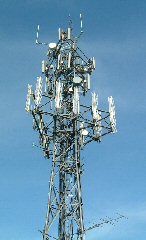


   |
What does it mean to measure mast emissions? |
|||
|
Extremely low frequency pulsed electromagnetic radiation does affect living organisms. That means you and me. We are the experiment. |
ICNIRP compliance is not so straightforward Whether you decide if the ICNIRP guidelines protect us or not, you should know that the radiation exposure from all mobile masts is not as simple as it is usually presented. The general idea we are given is like this diagram from the NRPB. It is important that, in conveying complex ideas, some simplification is used. However, in planning guidelines and in legal discussions, simplifications like this are still used. And they should not.
The image of a mast of any kind is that a wedge of radiation can be traced, and that as it spreads, the intensity of the energy dissipates roughly with the square of the distance. For this reason, we are consistently told that:
Planning guidelines therefore permit certain increases in antennae clusters on a particular mast, according to height, but allow as many antennae on separate masts in a single location as can be imagined. Planning guidelines and the Code of Best Practice for the same reason only require consultation and consent from schools and hospitals, for example, where the ‘main beam’ (stated as between 50 and 200 metres) falls on the buildings or grounds. Compliance of a mast, when measured by Ofcom or the NRPB, takes simplified readings to see if ICNIRP levels are being exceeded, in a particular place and at a particular time. No especial care is taken to measure levels at first floor bedrooms or lofts, or when the systems are concurrently at their busiest. (Mobile phone masts are very quiet on a Sunday morning, whereas TETRA is the same 24/7.)
ObservationsDevices are available to ordinary people that measure, compare or simply reveal, anomalies to this presentation of the situation. The COM monitor indicates levels of microwaves in volts/metre, and the Acousti-COM translates unamplified pulsed microwave signals into sound. What these show is that the levels of microwave exposure in an area are very far from uniform, and that by and large the ‘umbrella effect’ (see diagam above) does not exist. We have learned that when the TETRA Airwave antenna arrays were designed by BT engineers, they incorporated crescent-shaped shields under the arrays to shield people underneath. These were purchased from the US, but never installed, as being to expensive to place on every mast. Why, if TETRA is so safe would this be necessary in the first place? Most sites that describe antenna characteristics will tell you about ‘side lobes’, which are zones outside the neat wedge shape above, where intensity is high. These occur around masts and under masts. These must not be ignored. Further, where antenna emissions overlap, or simple where reflection takes place, the frequencies interfere with each other. Where the interference is destructive (a wave ‘on the up’ meets a wave ‘on the down’) intensity is reduced. Where the interference is constructive (a wave ‘on the up’ meets another wave ‘on the up’) intensity is increased. Since none of us lives in a flat desert, the amount of bouncing around, and of reflections from buildings, from bits of metal (often within structures but even in clothing), or from water pipes and storage, is very complex. Observations within buildings, especially homes, consistently show that radiation levels are ‘banded’ or layered. A short person may find their head is never in a ‘hot’ layer, whilst a taller person always is. Furthermore, hotspot bands appear horizontally as well, so when a horizontal and vertical band coincide, a highly local ‘very hot spot’ can appear. This can be exactly where your head is when sitting up in bed, or sleeping, or where you head is watching TV (perhaps with added TETRA interference), or doing the washing up. Where a number of masts are involved, on different frequencies, the result can be that overall power levels in a home stay consistently higher than might be expected. Masts positioned near reinforced concrete entrances can have their emissions focussed into a much more intense pattern of exposure. For example, two masts (GSM and 3G/UMTS) positioned at the mouth of two road tunnels in Southwick, Sussex, direct their beams inside, and create a radically different pattern of radiation of far greater intensity. Why does this matter?
In the case of the tunnels mentioned above, traffic frequently comes to a standstill, and workmen regularly undertake maintenance, quite unaware of the radiation. It is interesting that North Thames police have refused to use TETRA handsets at Ascot in the link tunnel, for precisely this reason. A parallel case is where multiple mobile phones being used in a railway carriage exceeed ICNIRP, and where police are not to use more than one TETRA handset in a vehicle without an external aerial.
Remember that all this is still mainly evaluated by the protection agencies as relating to the thermal effects of static microwaves, not biological effects or chronic exposure.
Further information and research
|
 TETRA in mast sharing. Government choice and saves planning, but with what combination effect? |
|
Home | |||